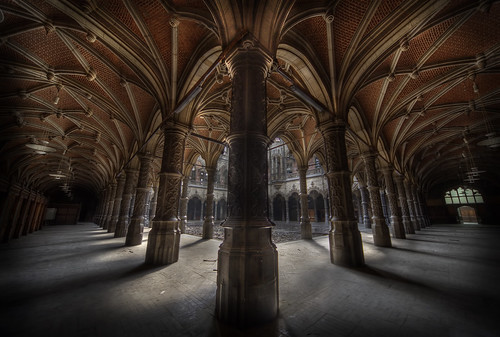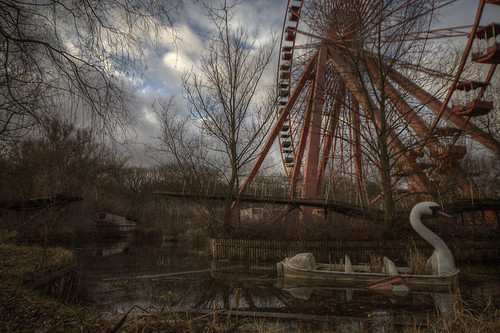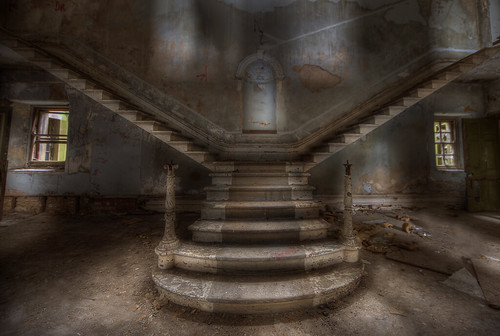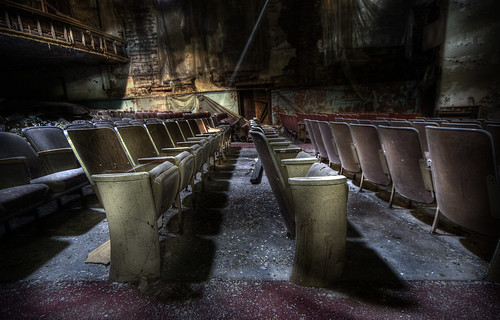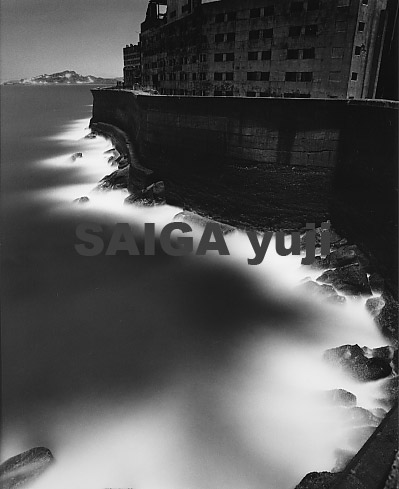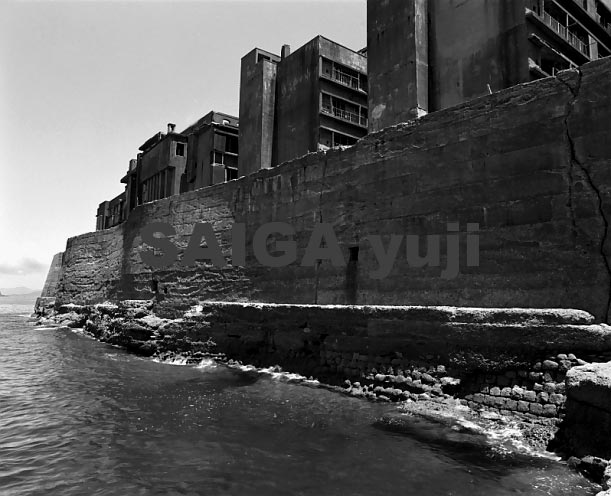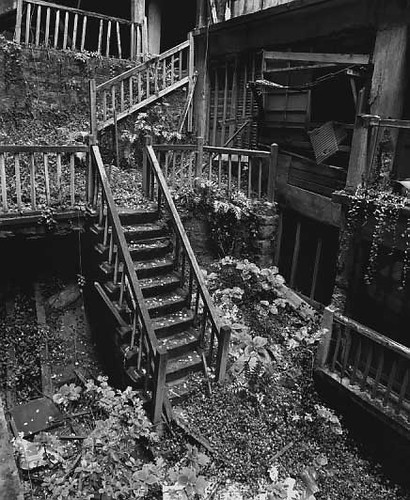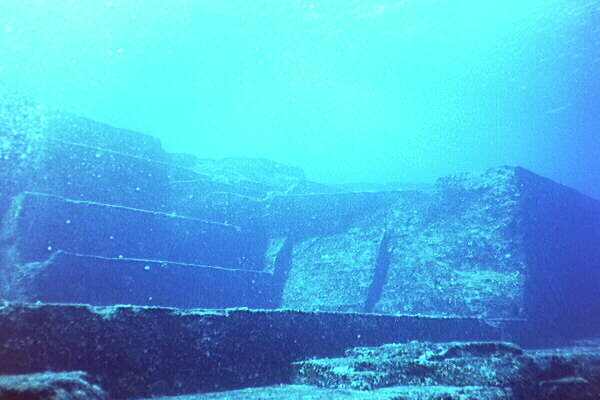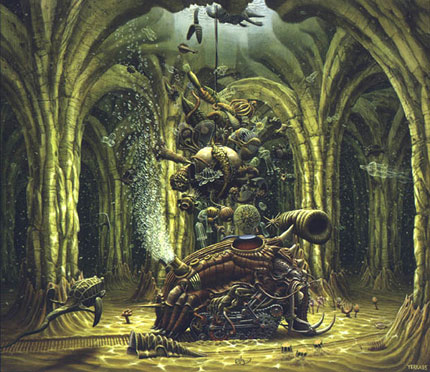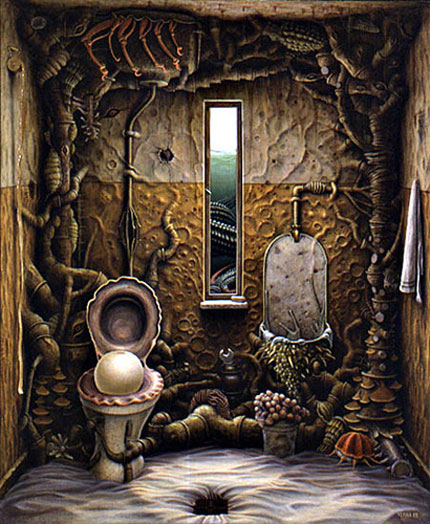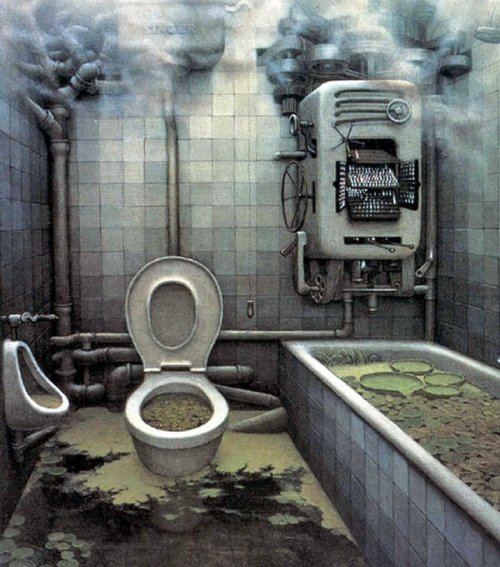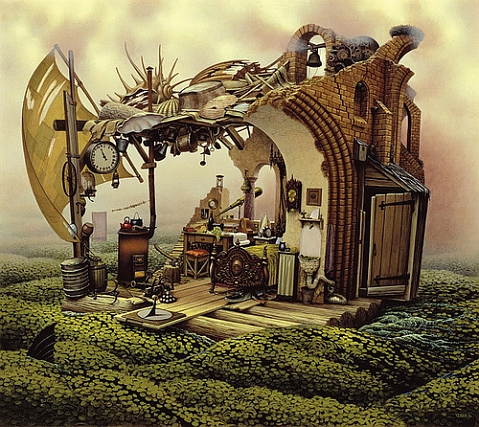Abandoned Spaces
The author asks the right question, why the fascination? But doesn't find an answer that satisfies me.
Why am I fascinated with abandoned ruins? What does it say about me? I don't know.
The Psychology of Ruin Porn
JoAnn Greco

Photo: Mathew Christopher
It's the sort of image, imbued with loss and layers, that architecture buffs drool over. A wheelchair sits center stage, its orange vinyl back echoed by a round tabletop that leans against a wall, painted in a familiar shade of institutional green. A mattress, flattened and grimy, lies tossed onto a floor that's littered with fallen plaster. In the foreground, an overturned metal trashcan speaks volumes. A mirror reflects the whole sad scene.
It's romantic, it's nostalgic, it's wistful, it's provocative. It's about time, nature, mortality, disinvestment.

Photo: Mathew Christopher
Pursuing and photographing the old is an addictive hobby. Dozens of blogs and online galleries share strategies for entry and showcase ever-bulging collections of moss-covered factory floors and lathe-exposed school buildings.
There's no shortage of theories as to just why these images (in this case, a long-shuttered mental asylum) fascinate us. They "offer an escape from excessive order," says Tim Edensor, a professor of geography at Manchester Metropolitan University who studies the appeal of urban ruins. "They're marginal spaces filled with old and obscure objects. You can see and feel things that you can't in the ordinary world."
Len Albright, a 31-year-old Princeton post-doctoral student who's tagged along with ruin explorers in Chicago, Cleveland, Philadelphia, and Pittsburgh, believes the experience is "more about the sense of ownership than anything else."
He describes the derring-do involved in scaling urban ruins. "There's this whole strategy for figuring out how to get in," he says. "They start by hiding in the tree line at the edge of the property, checking for security guards. Then one of them dashes to the wall of the building. He starts looking for unlocked doors or busted out windows. There's a lot of creeping and crawling, almost like a military operation."
But for Matthew Christopher, the man who snapped the photograph described above, it was — at least in the beginning — more about curiosity. Only as he stood amid the eerily silent hallways and peeling ceilings of a similarly crumbling institution did he truly understand its role in the history of mental health. "When I visited the abandoned Philadelphia State Hospital, and then some of the others, I was able to connect the dots, to see the progress of treatment through the years," Christopher says. "Architecture and the ethos of the times became linked for me."

Photo: Mathew Christopher
Reading about the field couldn't compete with actually seeing the buildings and complexes firsthand. "I realized this was real, not abstract," he says. Christopher became so intrigued with that first experience ten years ago that he switched from studying mental health to photography, eventually shooting some 300 abandoned asylums, schools, and factories.
"It was a case of that old cliché, 'a picture speaks a thousand words,'" he says. "When I'd try to talk about the presences that seem to linger in these places, people would look at me like I should be in an asylum myself. When I showed them pictures — they'd suddenly get it."
A long artistic history backs him up. Renaissance painters romanticized Greek ruins. Piranesi's etchings memorialized Roman antiquity as it was being torn up. Photographer Eugene Atget sought out whatever bits of a rapidly-disappearing Paris he could find in a post-Haussmann era.

Photo: Mathew Christopher
Now, Christopher has his own portfolio in the form of a website, abandonedamerica.us (subtitled "an autopsy of the American dream"), and he's studying fine art photography at Rochester Institute of Technology.
As part of a disparate cadre of urbanists who have embarked on the road to ruins, he's opened himself to some flack.
Critics accuse photographers like him of objectifying empty buildings as pretty stage sets filled with juxtapositions, fading colors and dramatic light. Those who are driven by the frisson of scampering around abandoned places, on the other hand, are often lambasted as criminal trespassers. Edensor thinks such invectives give these intrepid romance-seekers short shrift. "In the best photography, there's a silent comment on economic disinvestment through an attempt to capture the sensations and memories that remain," he says. "The conscientious explorer, on the other hand, seeks to create a relationship with the past, to produce a history that's not been museumized or curated by experts."
The two factions have, at times, gone to war. Urban explorers view photographers as passive watchers, unwilling to get their hands dirty. "Explorers move away from the porn metaphor, because it's all theirs to experience — not to watch," says Albright. "You poke your head into a hole, climb up a ladder, peer under a desk. You're trying to put together a story."
But photographers say they too put up with the slight dangers that come with the territory — Christopher has the Tyvek suit and breathing apparatus to prove it. More seriously, he contends, explorers can seem selfish, interested only in their own jollies.
"I'd like the viewer to step back just a bit and to see the horror story that's implicit in the image," he says."These pictures document physical conditions that are the direct consequences of failed economies."
With their more rebellious stance, explorers would probably issue a big meh to that idea, posits Albright.
"I've interviewed people who have been to the same building 20 or 30 times, they just love it so much," he says. "But when I asked them if they'd like to organize a cleanup or a preservation effort, they'd be indifferent. They might think that's fine for someone else to do ... after awhile, though, they'd be off to hunt for the next abandoned building."
All photos courtesy of Matthew Christopher.
http://www.theatlanticcities.com/design ... -porn/886/
Why am I fascinated with abandoned ruins? What does it say about me? I don't know.
The Psychology of Ruin Porn
JoAnn Greco

Photo: Mathew Christopher
It's the sort of image, imbued with loss and layers, that architecture buffs drool over. A wheelchair sits center stage, its orange vinyl back echoed by a round tabletop that leans against a wall, painted in a familiar shade of institutional green. A mattress, flattened and grimy, lies tossed onto a floor that's littered with fallen plaster. In the foreground, an overturned metal trashcan speaks volumes. A mirror reflects the whole sad scene.
It's romantic, it's nostalgic, it's wistful, it's provocative. It's about time, nature, mortality, disinvestment.

Photo: Mathew Christopher
Pursuing and photographing the old is an addictive hobby. Dozens of blogs and online galleries share strategies for entry and showcase ever-bulging collections of moss-covered factory floors and lathe-exposed school buildings.
There's no shortage of theories as to just why these images (in this case, a long-shuttered mental asylum) fascinate us. They "offer an escape from excessive order," says Tim Edensor, a professor of geography at Manchester Metropolitan University who studies the appeal of urban ruins. "They're marginal spaces filled with old and obscure objects. You can see and feel things that you can't in the ordinary world."
Len Albright, a 31-year-old Princeton post-doctoral student who's tagged along with ruin explorers in Chicago, Cleveland, Philadelphia, and Pittsburgh, believes the experience is "more about the sense of ownership than anything else."
He describes the derring-do involved in scaling urban ruins. "There's this whole strategy for figuring out how to get in," he says. "They start by hiding in the tree line at the edge of the property, checking for security guards. Then one of them dashes to the wall of the building. He starts looking for unlocked doors or busted out windows. There's a lot of creeping and crawling, almost like a military operation."
But for Matthew Christopher, the man who snapped the photograph described above, it was — at least in the beginning — more about curiosity. Only as he stood amid the eerily silent hallways and peeling ceilings of a similarly crumbling institution did he truly understand its role in the history of mental health. "When I visited the abandoned Philadelphia State Hospital, and then some of the others, I was able to connect the dots, to see the progress of treatment through the years," Christopher says. "Architecture and the ethos of the times became linked for me."

Photo: Mathew Christopher
Reading about the field couldn't compete with actually seeing the buildings and complexes firsthand. "I realized this was real, not abstract," he says. Christopher became so intrigued with that first experience ten years ago that he switched from studying mental health to photography, eventually shooting some 300 abandoned asylums, schools, and factories.
"It was a case of that old cliché, 'a picture speaks a thousand words,'" he says. "When I'd try to talk about the presences that seem to linger in these places, people would look at me like I should be in an asylum myself. When I showed them pictures — they'd suddenly get it."
A long artistic history backs him up. Renaissance painters romanticized Greek ruins. Piranesi's etchings memorialized Roman antiquity as it was being torn up. Photographer Eugene Atget sought out whatever bits of a rapidly-disappearing Paris he could find in a post-Haussmann era.

Photo: Mathew Christopher
Now, Christopher has his own portfolio in the form of a website, abandonedamerica.us (subtitled "an autopsy of the American dream"), and he's studying fine art photography at Rochester Institute of Technology.
As part of a disparate cadre of urbanists who have embarked on the road to ruins, he's opened himself to some flack.
Critics accuse photographers like him of objectifying empty buildings as pretty stage sets filled with juxtapositions, fading colors and dramatic light. Those who are driven by the frisson of scampering around abandoned places, on the other hand, are often lambasted as criminal trespassers. Edensor thinks such invectives give these intrepid romance-seekers short shrift. "In the best photography, there's a silent comment on economic disinvestment through an attempt to capture the sensations and memories that remain," he says. "The conscientious explorer, on the other hand, seeks to create a relationship with the past, to produce a history that's not been museumized or curated by experts."
The two factions have, at times, gone to war. Urban explorers view photographers as passive watchers, unwilling to get their hands dirty. "Explorers move away from the porn metaphor, because it's all theirs to experience — not to watch," says Albright. "You poke your head into a hole, climb up a ladder, peer under a desk. You're trying to put together a story."
But photographers say they too put up with the slight dangers that come with the territory — Christopher has the Tyvek suit and breathing apparatus to prove it. More seriously, he contends, explorers can seem selfish, interested only in their own jollies.
"I'd like the viewer to step back just a bit and to see the horror story that's implicit in the image," he says."These pictures document physical conditions that are the direct consequences of failed economies."
With their more rebellious stance, explorers would probably issue a big meh to that idea, posits Albright.
"I've interviewed people who have been to the same building 20 or 30 times, they just love it so much," he says. "But when I asked them if they'd like to organize a cleanup or a preservation effort, they'd be indifferent. They might think that's fine for someone else to do ... after awhile, though, they'd be off to hunt for the next abandoned building."
All photos courtesy of Matthew Christopher.
http://www.theatlanticcities.com/design ... -porn/886/
nathan28 wrote:http://weburbanist.com/2011/01/10/the-e ... host-town/
Ruins of Detroit: "...the fabulous and vanishing ruins of my beloved Detroit."
Planetizen: Portland's Empty Urban Renewal Area
B'lyn Paper: Toxic timebomb? Neighbors want halt on Broadway tower until site is cleaned
WU: The (WU)ltimate 33-Part Guide to Abandoned Places
WU: Sleeping Giants: 12 Sky-High Abandoned Buildings
WU: Abandonment: 8 Cities That Might Not Make It
WU: Silent Skyscrapers: The Ghost Towers of Bangkok
viewtopic.php?f=8&t=31489

